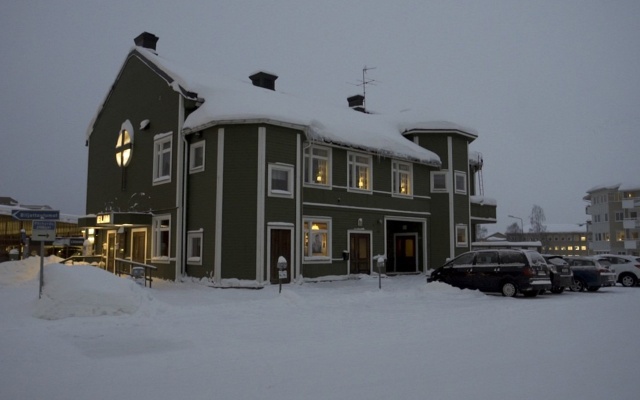Sandi Hilal Notes, 2019
Al-Madhafah/The Living Room
Located between the domestic and the public sphere, Al-Madhafah, in Arabic, is the living room dedicated to hospitality. It has the potential to subvert the role of guest and host and provide a different socio-political meaning to the act of hospitality. It seeks to mobilize the condition of permanent temporariness as an architectural and political concept capable of challenging the binaries of inclusion and exclusion, public and private, guest and host. It activates the rights of temporary people to host and not to eternally be a guest; the right to claim a life in their new destination without feeling obliged to revoke the desire of belonging to their life back home.
Al-Madhafah/the living room project has grown from a very personal need that became clear when I moved with my family to Sweden, where I carried with me the fear of living in the condition of what Edward Said beautifully describes as being “out of place.” Living in Europe, I’m constantly faced with, and challenged by, the description of integration as if it were something that will arrive sooner or later. That sooner or later I will consider part of the place where I live if I behave properly; like a good guest. But from my own experience, in the way it is understood within the framework of European nation states, integration is more like a race toward something; a perfection that few can ever attain. After moving to Sweden, I decided not to run that race, but rather to explore other ways of understanding, defining, and practicing integration. I decided not to accept my assigned role as a perfect guest, but to look for alternatives to comprehend inclusion by questioning who has the right to include or to exclude. Who has the right to host, and who is told they need to behave like a perfect guest? How can we analyze the power of hosting as a means of becoming visible and demanding agency? How can we understand visibility as a precondition for political subjectivity? How can we understand participation from the position of an outsider in Europe today without waiting years, sometimes even generations?
Arrival in the North of Sweden
Boden was first mentioned to me during a Skype conversation with Marti Manen and Joanna Zawieja from the Public Art Agency Sweden in July of 2016, who suggested the possibility of working together on a project with refugees who were arriving in a city called Boden in the far north of the country. They also mentioned that Boden is well known in Sweden as an important military stronghold that for a very long time was responsible for protecting Sweden from potential attacks by Russia during the Cold War. They also told me that the Swedish government was interested in creating public art in certain marginalized areas.
I arrived in Boden, 40 kilometers from the Arctic Circle, in November 2016 with fear and anxiety. I doubted my ability to engage with such an unfamiliar place and landscape. I was afraid that I simply lacked the basic skills.
What I was unable to realize back then was that this seeming lack of a connection to Boden allowed me to engage with both the city and its inhabitants in an extraordinary way. It also offered me the opportunity to reflect on my life and work in Palestine and Italy in a completely different way.
The Yellow House in Boden
In the commission from the Public Art Agency, they mentioned the Yellow House, which was well known in Boden for hosting refugees, as a possible starting point for the project. I was told that the Yellow House was a place with a bad reputation, that it caused problems … that refugees living there spent their days packed like sardines in small rooms, with cold weather and a dark sky outside and a winter that never seems to end. Social isolation was a serious problem, too. One resident of the Yellow House I spoke with told me: “I live with my wife and children all alone. No one knocks on our doors here, while in Syria we never closed our doors.” Another told me: “My deepest wish is for my wife to find a reason to leave this dark room every now and then.”
I was frustrated and saddened by what I saw but did not lose hope. I kept knocking on doors. A young Iraqi man, Ahmad, invited me into his room. We sat on his bed, and he told me that he was waiting for his wife and children, and that when he received family reunification papers and they finally arrive, they would move to the south of Sweden where the weather is nicer and people are more open. I could not help but exclaim, almost out of desperation: “Everybody wants to escape Boden! Doesn’t anyone want to stay here?!” I wasn't expecting an answer, but Ahmad responded, to my amazement: “You must meet Ibrahim and Yasmeen. They are not living in the Yellow House, but are considering staying in Boden.”
Yasmeen and Ibrahim’s Living Room in Boden
Yasmeen and Ibrahim live in a green house with a church on the second floor in the center of Boden. Ibrahim came out to greet us and welcomed us inside. Yasmeen was waiting for us in the corridor. I shook hands with her and looked shyly into her eyes before entering their living room. Suddenly the sadness of the Yellow House disappeared.
Marti and Joanna were with me during our visit. Looking around me I realized that I was accompanied by representatives of the Swedish Public Art Agency, in other words, by members of the government. In that small living room, by hosting us Yasmeen and Ibrahim simply switched familiar social roles: instead of being refugees hosted by the government, they played the role of host, hosting the Swedish government. Their living room gave them the opportunity to reject their role of obedient guest, complying with norms and rules, and exercise their right to be hosts.
Yasmeen, her mother and Ibrahim were our hosts, and they were hosting us with pride in their house as if thehad never lost their home.
In this living room, I found the strength that I had been searching for but was unable to find in the Yellow House. How can we convey this feeling to those around us? Is there a way to imbue others around us with this feeling? How can we bring hospitality back to the Yellow House as a means of creating agency? Ibrahim told me that when they first arrived in Boden, they desperately tried to invite everyone they would meet into their home. He explained: “In our house we are humans, but in public, we feel that we are just numbers. I wanted people to see me as a human and to appreciate who I am. This was possible only in our home.”
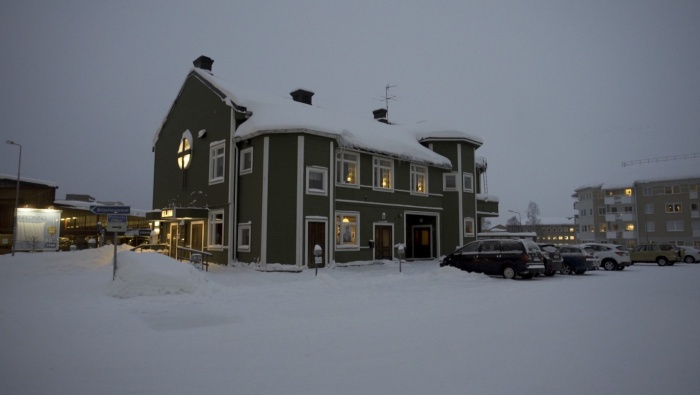
Dom Yasmeen i Ibrahima w Boden.
The Living Room of Yasmeen and Ibrahim in Boden and our DAAR in Stockholm
The encounter with Yasmeen and Ibrahim marked the beginning of the project. However, reducing it to something about a Syrian refugee couple would have been to limit the potential of their performance and their experience. Their living room made me realize how important it would be to use our own living room in Stockholm as a way to discover and settle into our new Swedish life. As their living room and ours are part of the same whole, it became more difficult to narrow the project down to something that is exclusively about refugees.
This encounter made me understand better why, more than a decade ago in 2006, my partner Alessandro Petti and I decided to open up our house and initiate DAAR, which means “home” in Arabic. Our home back then in Beit Sahour, meant the creation of a quasi-institution (DAAR) in our own private space as a response to the lack of public space in Palestine where we could discuss how to live under colonialism and how to rethink struggles for decolonization and the creation of common spaces. Our DAAR in Stockholm would still aim to function as a quasi-institution, as a response to the lack of political agency in the public sphere in Europe today.
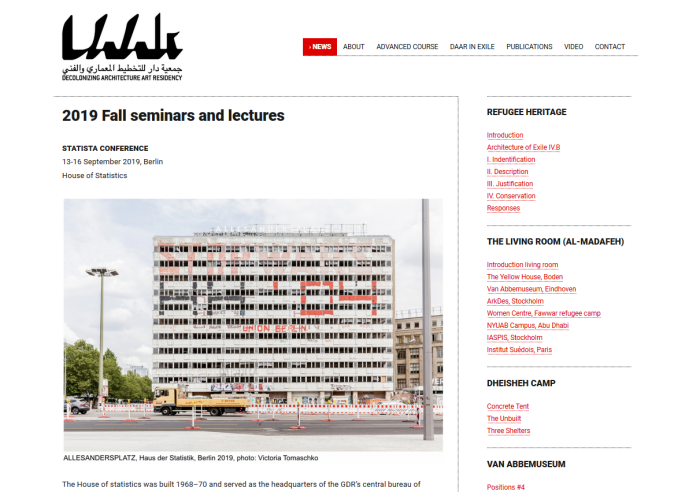
Printscreen strony internetowej – www.decolonizing.ps.
The Living Room in the Yellow House in Boden and ArkDes
This collaborative process led the municipal housing company BodenBo to offer us a ground floor apartment in the Yellow House to create a public living room. At the same time, I was invited to take part in an exhibition at ArkDes, the Swedish Centre for Architecture and Design in Stockholm. This invitation gave me the opportunity to “amplify” my own living room as a public space in the museum while Yasmeen and Ibrahim could do the same in the Yellow House.
The challenge in both spaces was to provide the public dimension with a private sphere. In the Yellow House, we asked the engineer to tear down all the walls and keep only the load-bearing ones. Yet at ArkDes, the need was the opposite: by building a threshold of four walls and three doors, a private space was created in the already public space of the museum.
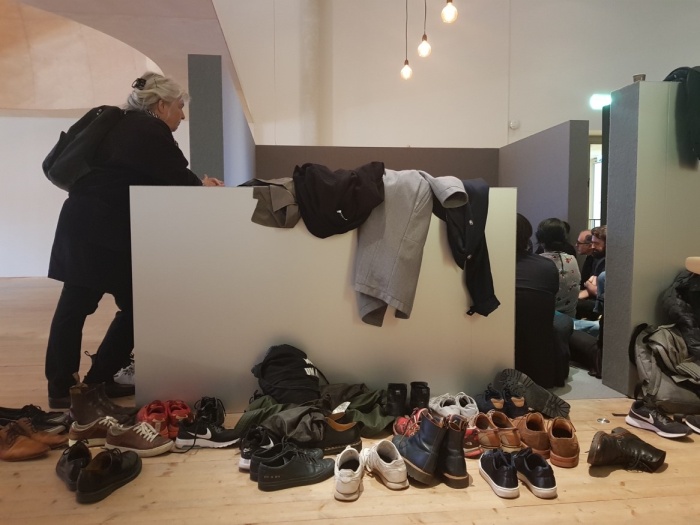
ArkDes, Sztokholm, 2018.
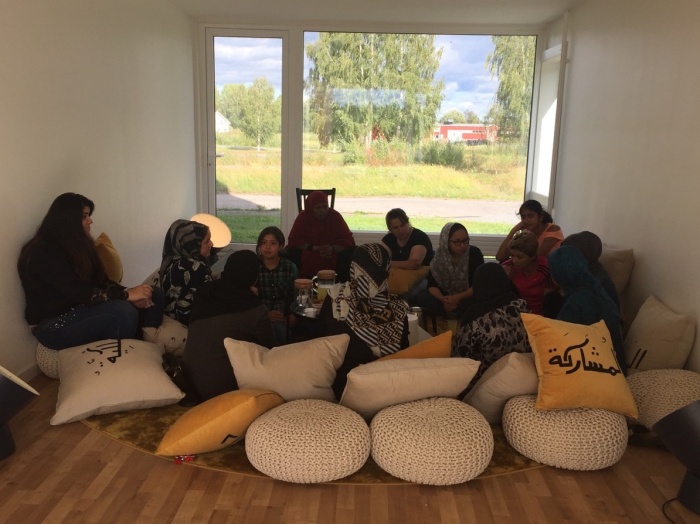
Żółty Dom, Boden, 2018.
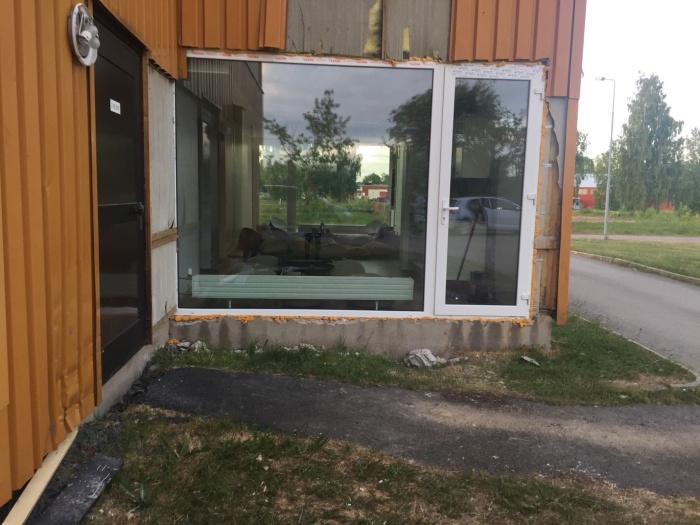
Żółty Dom, Boden, 2018.
The Living Room in ArkDes and Fawwar Refugee Camp in Palestine
The design of the living room in ArkDes was inspired by the square that we designed in Fawwar refugee camp. There, it became clear that in the absence of the state, the only way to manage the public space in the camp was to create a threshold: four walls and four doors that could create the intimacy people needed to use as well as manage the space.
Years later after the design of the plaza of Fawwar, the Madhafah /the living room was created in the Fawwar refugee camp itself and was set up by Ayat Al Turshan, a former participant of Campus in Camps. Her living room is slightly different from ours in Sweden. In Fawwar, living rooms are typically run by men, and Ayat had long been involved in working for the rights of women to go out in public in the Fawwar Plaza. Thus, the concept of madhafeh and a space owned by both men and women, where women can claim the right to host, is highly controversial.
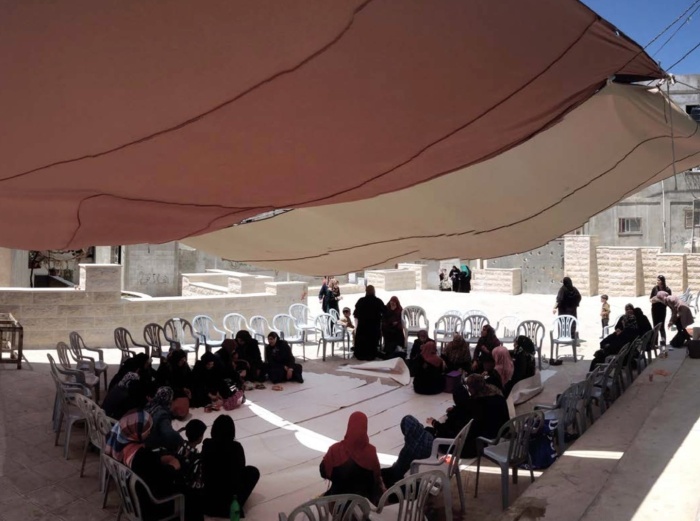
Fawwar, obóz dla uchodźców, Palestyna, 2015.
The Living Room in Ramallah Municipality and Fawwar Refugee Camp
Another temporary living room was created in Ramallah in collaboration with the municipality in October 2018. In the context of Qalandia International, Ayat brought her madhafeh from Fawwar to Ramallah. It is essential to think of the project as a network of madhafehs that generates a movement of people who see the possibility of fully exercising their own agency in the act of hospitality. The presence of Ayat in Ramallah is a perfect example of this. By bringing her madhafeh from Fawwar to Ramallah, Ayat's living room will gain a public dimension and hence greater legitimacy in her own community. Moreover, her presence will bring the voice of the camp to the very heart of the city, and thus gain the political and social recognition that Ayat craves and needs to continue her work.
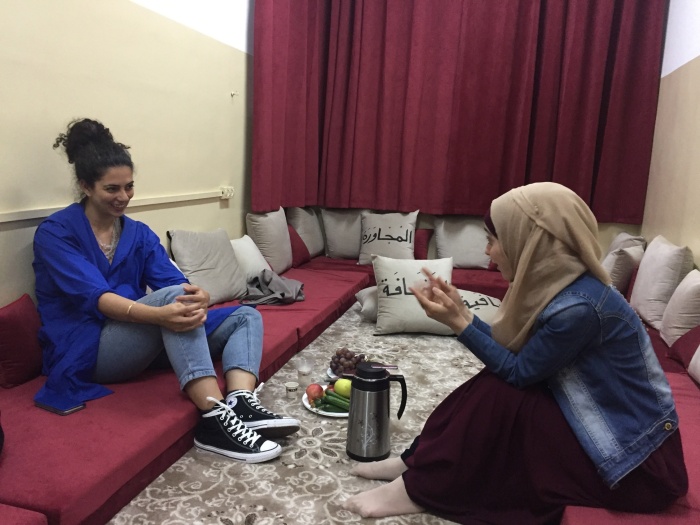
Al-Madhafah w centrum programu kobiet, obóz dla uchodźców Fawwar, 2018.
The Living Room at the Van AbbeMuseum
During our show “permanent temporariness” in the Position #4 Exhibition at the Van AbbeMuseum, both my partner Alessandro Petti and I were very doubtful whether the living room could make sense in a museum in a city like Eindhoven, where we do not live. When I first decided to start the living room in ArkDes, it was because I perceived myself as the host there. While living in Stockholm, I lived in my own private living room in the public space of the museum as an attempt to expropriate the public and to claim visibility and political subjectivity in a city where I was a newcomer.
In the case of the Van Abbemuseum, we were afraid that the living room would become an art installation and an object in a white cube. Before making a decision, I decided to pay a visit to Eindhoven. I arrived at the entrance to the museum and told the person at the desk to tell Jantine in administration that I had arrived so that someone from inside could come and let me in. While I waited, I met Shafiq, the museum’s Afghani guard. I began to chat with Shafiq, and I told him about the living room. He instantly understood the project and we immediately bonded. While we chatted I told him that the only condition for this project to exist was for a Host to come forward... he replied with no hesitation: “I'm the host.” Charles Esche, the director of the museum, arrived at the entrance to pick me up, he looked at both Shafiq and me and said: “I see you both met already.” I looked at him and said: “Yes and we already figured out how to do the living room.” I laughed and said, “Now I can go back home to Stockholm.” Charles told me that they had organized a very packed program for me during the coming days. I replied that I was entirely open but that my intuition and my connection to Shafiq was already a solid basis for the living room to be designed in the Museum. Before I went back to Stockholm, Shafiq and I agreed to keep in contact to decide how to approach the set-up of the living room. I told Alessandro how excited I was about meeting Shafiq. I explained how our encounter on the threshold and our long conversation there was definitely a strong sign. Alessandro suggested we should build the Safiq’s living room at the threshold of the museum.
We designed the living room at the entrance, and I suggested a round golden carpet for the living room so guests could sit in a circle. Shafiq suggested bringing a rug from his home so that he would feel a sense of belonging to this new living room in the museum. The morning before the opening I went with Shafiq to buy what was needed for him to serve Afghani tea alongside sweet and savory snacks in the living room. Every time I went to the Van Abbemuseum, what I most looked forward to was sitting in that circle drinking Shafiq's tea.
Not only was Shafiq the host now, but he also invited other rejected Asylum seekers to be hosts in the living room. In one fascinating discussion in the living room, Shafiq mentioned that the rejected asylum seekers came only two at a time so they would not end up just socializing amongst themselves. They had already built up a strong sense of solidarity, and they were already a community. They told me that: “What the threshold at the entrance of the museum offered us was an opportunity to meet people from Eindhoven and all over the world with whom we would not ordinarily have come into contact. This is exactly what the museum can provide, and it’s something that we couldn’t have achieved alone.”
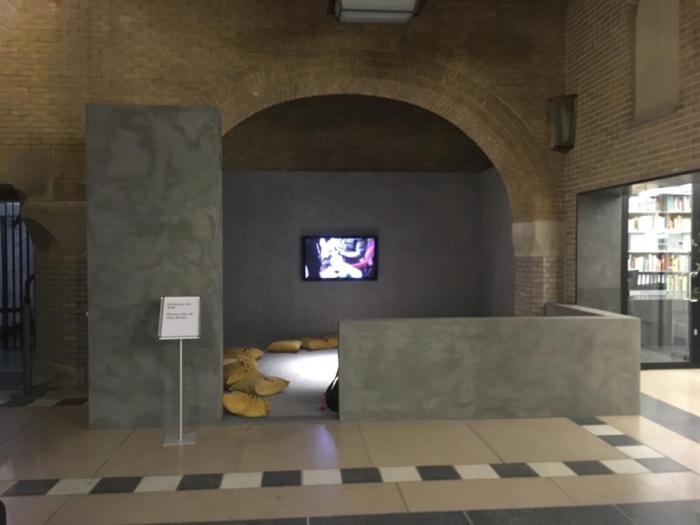
Van Abbemuseum, Eindhoven, 2019.
The Living Room at the Institut Suédois in Paris
When the Public Luxury exhibition was to be moved from ArkDes to the Institut Suédois in Paris, I was asked if I would be interested in showing the living room there. I received an email with beautiful photos from the Institut Suédois as a proposal on where to locate the living room within the exhibition. I felt overwhelmed. Each time I’m invited to do a show or a project, to find the host and to activate the living room I’m not sure if it was possible,. I sent an email explaining that the living room is not an art installation and that it cannot simply move to Paris without thinking about its activation during the exhibition. I received a reply from Ewa Kumlin telling me that she was in Stockholm and suggesting that we meet at ArkDes. We met in Cafe Blom at ArkDes and were unable to stop talking; we felt we had a lot to share. Ewa explained why she was very keen to have the project at the Institut Suédois. She mentioned how she is personally invested in the way we can collectively understand hospitality today, and explained how hospitality had been an essential practice at the center of her life since childhood. We discussed the importance of reintroducing the concept of hospitality today into Swedish institutions and society from different perspectives. We talked about the risk of forcibly separating private life from public life, and she told me how she felt the need to create rituals such as inviting people to share a pizza and a box of wine as a way to create a community in her own living room. She also explained to me that she has been always following her Husband as a diplomat in many parts of this world and that her living room in each new place she arrive to was her entry point to that place and when she encounter the project and the right to host she understood her need of opening her living room as a way to be part of the place in her own terms. We discussed this and many other things. As we talked, I was thinking about the difference between what she was saying and me raising the urgent need to bring hospitality back into the center of the way society is organized in Sweden today. My ideas could be interpreted as me criticizing Sweden; hers would undoubtedly be more constructive. There is so little that we can do about identity politics, except sometimes try to create alliances that can go beyond our national identities. I promised Ewa I would think about how to present the living room in Paris. I suggested that maybe we just needed to announce that we were still looking for the host. Coming back home Alessandro asked me why I’d changed my mind, and why I was now open to showing the living room in Paris. I replied that I liked Ewa and thought that it would be nice to do something together. Alessandro suggested that I should concentrate on what made me change my mind. I slept on it for a few days; then something hit me: what if Ewa was the host? Before meeting Ewa, I thought about hospitality as a way for refugees and foreigners to gain agency. I always positioned myself as a privileged artist and architect in Sweden, yet also a Palestinian outsider. What was mind-blowing for me was the realization that both Ewa and myself need hospitality to break social codes, each in our own domain. It is precisely from within this kind of threshold that we can create alliances that go beyond class, gender, or social status.

Dom Ewy w Instytucie Szwedzkim w Paryżu.
Collective recognition
This collective recognition is at the core of the idea of the living rooms, as each living room brings strength and visibility to the others. As Yasmeen gave me strength through her hospitality, I am now giving strength to Ayat. This network allows us to look at ourselves in the mirror and understand our own lives through the experiences and stories of others, however different they may be. None of us was capable of creating a sense of belonging to the public by ourselves, but we all shared the desire to contribute to the life of the place we live in.
BIO
Sandi Hilal is an architect, artist and educator, she is currently developing an ongoing artistic research project centered around the concept of Hospitality manifested through the project Al-Madhafah: the hospitality room and the right to be a host.
She is a founding member and Director of DAAR- Decolonizing Architecture Art and residency (http://www.decolonizing.ps).
Hilal is among the founders of Campus in Camps, an experimental educational program established in Dheisheh Refugee Camp, Bethlehem (http://www.campusincamps.ps). She headed the infrastructure the infrastructure and Camp Improvement Program in the West Bank at United Nations Relief and Works Agency for Palestine Refugees in the Near East (UNRWA) from 2008 to 2014 (http://www.unrwa.org/what-we-do/infrastructure-camp-improvement).
In 2006, she obtained the title of research doctorate in transborder policies for daily life in the University of Trieste (http://www.iuies.org).
* Cover photo: Yasmeen and Ibrahim's house in Boden.



